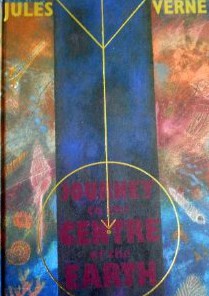Inspiring Older Readers
 posted on 16 Mar 2016
posted on 16 Mar 2016
Journey to the Centre of the Earth by Jules Verne
In Germany, Professor Lidenbrock has developed an obsession – he wants to follow in the footsteps of the Icelander, Arne Saknussenum and undertake a journey to the centre of the Earth - but only once he has translated the ancient runic clues the ancient adventurer left behind. He’s going to take his nephew Axel and a placid, imperturbable servant and handyman called Hans - but he has no real idea what he’s going to find and he doesn’t seem to have much of a plan.
Verne’s 1864 science fiction novel is precisely that – science used to make fiction. No aliens, no space trips, no other-dimensional adventures but a story based on science, in this particular case geology and early earth sciences.
The first half of the book is really a wilderness travelogue as the three men make their way to the north of Iceland to find the volcanic vent that will give them access to the route they will follow to the Earth’s centre. Once they have begun their descent however the story begins to pick up pace and the level of jeopardy steps up a notch.
It’s at this point that any sane reader would start to have some doubts about Professor Lidenbrock’s credentials as a scientist. Axel, although undoubtedly the physical weak link in the group, is certainly the rational one – it is he who points out that temperature and pressure would effectively prevent anyone getting anywhere near the centre of the Earth – which is in any case molten. The good Professor responds to this clear-minded critique by simply asserting volubly that science is wrong. Hmmm......
They begin a descent and nearly die of thirst when they take a wrong turning and head off into a series of arid tunnels. They retrace their steps and are saved by uncovering an underground stream and begin to find evidence that this was the route taken by Saknussenum. Lidenbrock is proved right and neither temperature or pressure cause them a problem ( What? How??) but they are hopelessly diverted by coming across a huge underground ocean with its own weather system. They set out onto the water aboard a raft constructed by Hans and when they hit the shore they find a whole self-contained ecosystem – with giant mushrooms, trees and other vegetation. Here too they stumble on the bones of animals that have been long extinct on the surface and there is also a close encounter with a primitive ape-like primate.
Trying to follow Saknussenum’s route and hoping it will lead them towards some kind of exit they discover the way blocked by a rock-fall. They use gun-cotton to blast a hole in the rock but inadvertently open a bottomless pit rather than the way to the Earth’s centre. Water from the underground sea rushes through the hole they have created and sweeps them away in a torrent until they find themselves diverted into another volcanic chimney and ejected in an eruption from what turns out to be Stromboli.
As an adventure story it’s a very simple tale and it’s easy to see how this gets frequently recycled in edited form as a narrative for children or younger readers – it’s also no surprise that several film versions exist too. The book however is a very oddly paced piece of writing – when it rattles along it’s great but there are some very stop/start passages where the exposition of science is clearly more important than the pace of the storytelling. This really is ‘science fiction’ in the literal meaning of that term. Theories of geology, topography, biology and earth sciences get an extensive outing and, rather frustratingly, most of them remain only in outline – brushed aside as inconvenient facts by the bull-headed, bullying and dogmatic Lidenbrock.
I found this an odd read. It felt much longer than the 180 pages and it is hard to read this now without being acutely conscious of the fact that the idea of a world within a world is simply silly – our understanding of the structure of the Earth has progressed to the point that suspension of disbelief is virtually impossible and it’s not helped by an essentially flimsy story that has only a hint of suspense or fear.
Classic it might be but maybe the abridgments and the film treatments have, for once, got it right by filleting out the archaic science and focussing on the derring-do .
Terry Potter
March 2016